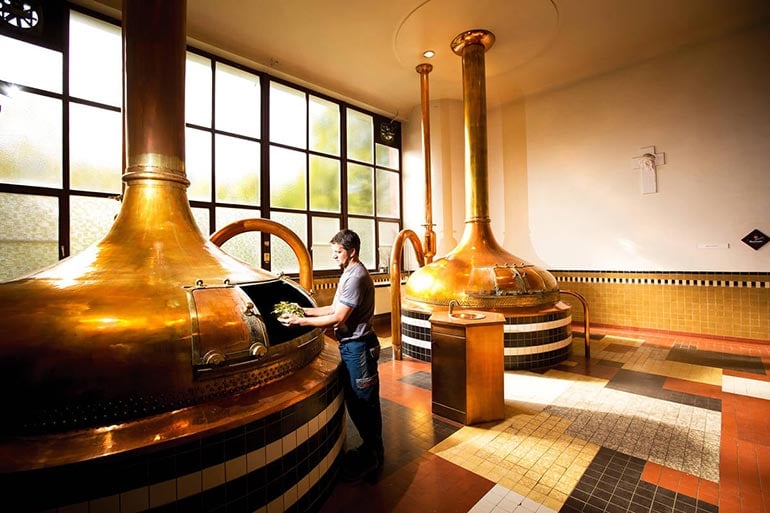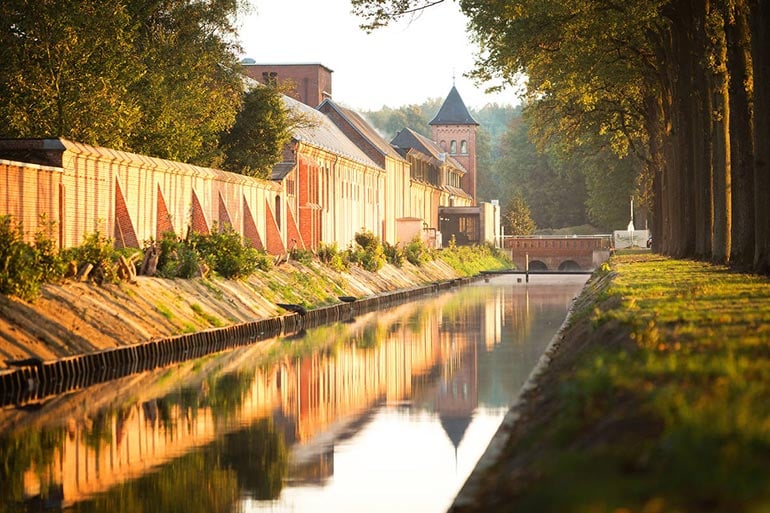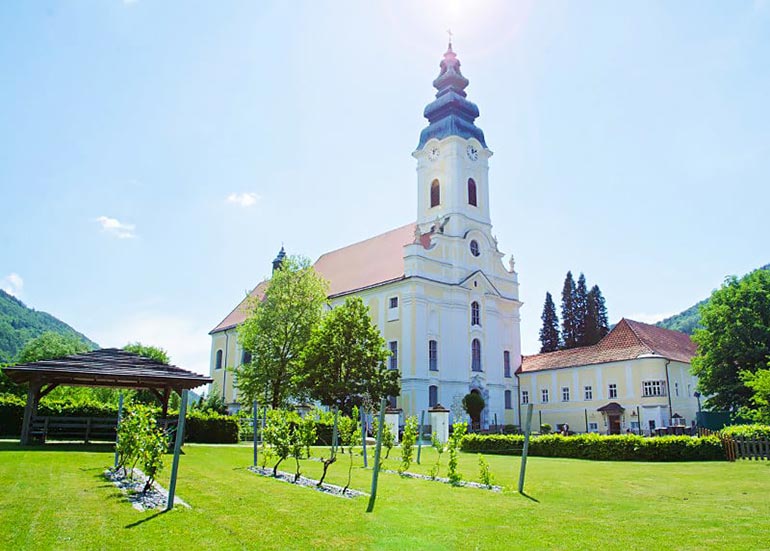Start 14-Day Trial Subscription
*No credit card required

The Almighty Trappist Beer
Discover the divine essence and the sacred origins of Trappist ales. Learn about the revered monks who craft these heavenly elixirs within the serene confines of their monasteries. Delve into the rich history and tradition behind Trappist brewing, guided by the principles of St. Benedict's Rule.
Few beers remain holier in the eyes of the drinker than Trappist beer. Revered for their heavenly attributes, these beers find beauty in simplicity, serving as a reflection of their makers. While the Trappist monks who brew these illustrious ales live under the straightforward Rule of St. Benedict – known for the Latin mottos “pax” (peace) and “ora et labora” (pray and work) ‒ there remains considerable confusion around the subject of these holy brewers and their creations. From henceforth, we shall codify the history and habits of the nuns and monks, as well as the range of blessed elixirs that emanate from their abbeys.
Trappists are followers of the Order of Cistercians of the Strict Observance (OCSO: Ordo Cisterciensis Strictioris Observantiae). The OCSO is a Catholic religious order made up of “cloistered contemplative monastics” (monks and nuns) who follow the Rule of St. Benedict. Written in the sixth century, St. Benedict’s work guides Trappists by outlining the principles of ‒ and rules for ‒ monastic life. Monks are referred to as “Trappists” and nuns “Trappistines.”
The name “Trappist” was born in the Cistercian abbey of La Trappe, located in Soligny, France (not to be confused with the Dutch La Trappe beer line by Trappist Brewery Koningshoeven). In 1664, La Trappe’s abbot decided that the Cistercian order had become too liberal and reformed the abbey rules to follow a stricter order. These days, the rules are a bit more relaxed, but the core tenets remain.
The “Strict Observance” refers to the aim of following St. Benedict’s Rule after taking the three vows he describes: stability, fidelity to monastic life and obedience.
What About Trappist Monks?
A common misconception is that these monks have taken a vow of silence, but the truth is that Benedict simply discouraged chit-chat because it interrupts a disciple’s “quietude and receptivity, and may tempt one to exercise one’s own will instead of the will of God.” Thus, a Trappist will only speak when necessary. Forbidden speech includes that which leads to “unkind amusement or laughter.” So, while Trappists may smile sublimely after imbibing an ale, they likely won’t be telling too many jokes.
Unsurprisingly, Trappist monks and nuns have developed their own unique form of sign language, which more or less makes up for their lack of speech. Mealtime is quiet, too, so rather than passing their compliments to the chef and creator after a meal, a monk or nun might give a thumbs-up, or the monastic equivalent.
As for what Trappists eat, they mostly stick to a vegetarian diet, choosing to consume fruits, veggies, beans and grain. Some may branch into pescatarianism (eating fish), but they strictly abstain from “four-footed animals.”
Generally, the Trappists eat what they can grow themselves and drink what they can collect on their own … or brew themselves.
Monks of different orders have brewed beer for their own consumption since the Middle Ages, choosing hearty ales that help tide them over during fasts. These ales would also serve to support the community and provide a reliably clean source of hydration.
For Trappists, the brewing tradition is said to have begun with the original French La Trappe Abbey, which is on record as having a brewery as early as 1685. From there, Trappist breweries spread throughout Europe, though many original monastery brewhouses have since been destroyed in Europe’s numerous wars.
You’ve more than likely had a Trappist beer before, but what gives it the holy prefix?
Trappist beer is a beer brewed by a Trappist brewery, allowing it to bear the mark of an “Authentic Trappist Product,” as determined by the International Trappist Association. There are around 170 Trappist monasteries in the world, with about two-thirds in Europe, and the rest split fairly evenly between Africa, Asia and the Americas.
Of these monasteries, only 12 produce and sell beer and can display the Authentic Trappist Product logo – six in Belgium, two in the Netherlands, and one each in Austria, Italy, the U.K. and the U.S.
Among these 12, there’s a newcomer to the group ‒ the U.K.’s first true Trappist ale. Mount Saint Bernard Abbey in Leicestershire, England, was accredited by the ITA earlier this year, and has just begun selling Tynt Meadow, a 7.4 percent ABV English Strong Ale with a full body and notes of chocolate and rich fruit in nose and flavor, with a peppery, boozy finish.

Trappist beer is a beer brewed by a Trappist brewery, such as Westmalle Brewery (above), allowing it to bear the mark of an “Authentic Trappist Product,” as determined by the International Trappist Association.
Defining Trappist Beer
To become accredited, Mount Saint Bernard had to meet the same standards the other 11 breweries did, which are laid out as follows:
- The beer must be brewed within the walls of a Trappist monastery, either by the monks themselves or under their supervision.
- The brewery must be of secondary importance within the monastery and it should follow business practices proper for a monastic way of life.
- The brewery is not intended to be a profit-making venture. The income covers the living expenses of the monks and the maintenance of the buildings and grounds. Whatever remains is donated to charity for social work and to help persons in need.
For a time, the terms “Trappist ale” and “abbey beer” were interchangeable until the International Trappist Association officially defined what a Trappist ale was. In doing so, it also laid out the terms for what qualifies as an abbey beer:
- Produced by a non-Trappist monastery — e.g. not a Cistercian, Benedictine monastery; or
- produced by a commercial brewery under an arrangement with an extant monastery; or
- branded with the name of a defunct or fictitious abbey by a commercial brewer; orgiven a vaguely monastic branding, without mentioning a specific monastery, by a commercial brewer.
An example of an “abbey beer” (Bières d'Abbaye or Abdijbier) as opposed to a trappist beer, is the one produced by the Spanish monastery of San Pedro de Cardeña. The monastery sells a contract-brewed Tripel, and as such, it is not allowed to bear the official Trappist logo, since its monks do not brew the beer.
Beyond beer, the ITA accreditation process extends to any product made by Trappists, who produce a variety of artisanal goods. This prolific production stems from the 48th chapter of the Rule of St. Benedict, which states, "for then are they monks in truth, if they live by the work of their hands." These handcrafted items include cheeses, jams, bread, fruits and other food products along with clothing, coffins, bonsai trees and more.
But let’s get back to the beer. We know what earns a Trappist classification, so what kinds of beer do the monks brew?
Trappist beers are generally top-fermented and bottle-conditioned, following a fittingly straightforward numbering system to describe relative strength, color and original gravity. Exact nomenclature may vary from brewery to brewery, though beers are usually labelled “Enkel” (single), “Dubbel” (double), “Tripel” (triple) or “Quadrupel” (quadruple or quad). One, two, three or four … but Rochefort uses numbers (6, 8, 10), Chimay uses colors (red, white and blue), and Westvleteren doesn’t use any label.
A Trappist Enkel is a brewery’s weakest beer (4.8 to 6 percent ABV) and less likely to be commercially marketed. An Enkel is generally interchangeable with the term “patersbier” (father’s beer), most often only brewed for consumption among the monks. This low-ABV style is more functional – used to hydrate, nourish and allow clearheaded contemplation. It may also be called a Blond.
The Trappist Dubbel (6 to 8 percent ABV) is generally a sweetish, fruity and full-bodied brown ale, first attributed to Westmalle in 1856. This ale is one of the most commonly commercially imitated Trappist beer styles.

Westmalle Brewery is credited with brewing the first Trappist Dubbel, perhaps the most recognizable style in the Trappist Ale family.
The Tripel has also been adopted heavily in the commercial realm, as its high alcohol content (8 to 10 percent ABV) and almost champagne-like character make it a favorite celebratory brew. Unlike the Dubbel, this style is usually pale yellow to golden in color, with a bit more bitterness and burn, and less body. This bold pale ale style is also attributed to Westmalle, originating in name in the 1930s.
Lastly, we have the Quadrupel, somewhat of a catch-all designation for any beer over 10 percent ABV. One can expect these ales to be thick, dark, ripe, fruity and full-bodied. This name was coined by La Trappe for its hearty seasonal offering.
Though some might view these simple classifications as unimaginative or even boring compared with the current craft scene in America, keep in mind that a Trappist ale is synonymous with quality, and these ales are some of the finest statements of brewing craftsmanship the world has known. They are the definition of quality over quantity, and age like fine wine.
Famous Trappist Breweries Around the World
Now that we have a bit of background into the rich Trappist tradition, let’s take a look at its modern flag bearers:
Brasserie de Rochefort
This brewery located in Rochefort, Belgium began producing trappist beer in 1595. Today it produces around 15,000 U.S. bbls between its three Trappist-designated beer offerings, Rochefort 6, Rochefort 8 and Rochefort 10 (Dubbel, Tripel and Quad respectively). Brewing liquor is drawn from a well within abbey walls, and its beers are made from Pilsener and Munich malts, and Hallertau and Golding hops.
Brouwerij der Trappisten van Westmalle
Located in the Westmalle municipality of Belgium, this brewery got its start in 1836. Today it brews about 100,000 bbls of trappist beer annually between its Dubbel and Tripel, along with its limited-availability patersbier, Westmalle Extra.
Brouwerij Westvleteren/St Sixtus
The third-oldest of the six Belgian Trappist Breweries, Westvleteren got its start in 1838 and is located in Vleteren, a municipality of West Flanders. Today, it brews only about 4,000 bbls of its three offerings – Westvleteren Blond, Westvleteren 8 and Westvleteren 12, the last of which is considered by many to be the single finest beer in the world. Not bad for a brewery run by just five people.
Bières de Chimay
Located at Scourmont Abbey in Hainaut, Belgium, Chimay began brewing in 1862. It offers four trappist beer: Red, Blue, Triple and Dorée (a limited, mostly self-consumed patersbier), which combined equal 105,000 bbls annually.
Brasserie d'Orval
Founded in 1931 at Orval Abbey in Gaume, Belgium, this brewer makes about 61,000 bbls yearly between its trappist two beers, Orval and Petite Orval, though Orval accounts for the vast majority of sales. Petite Orval is a patersbier generally limited only to the monks.
Brouwerij der Sint-Benedictusabdij de Achelse Kluis (Achel)
The most recent addition to Belgium’s rich Trappist history, this abbey began brewing in 1998 in the municipality of Hamont-Achel. It’s prolific in style, brewing six different varieties of blond, bruins and extra (patersbier), but not in quantity, amassing only about 3,800 bbls among its trappist beer offerings.
Brouwerij de Koningshoeven (La Trappe)
Located in Tilburg, the first of the Netherlands’ two breweries began brewing in 1884, following the tradition of the original French La Trappe. At 124,000 bbls a year, it is the largest Trappist brewery and produces a range of year-round and seasonal trappist beer releases.
La Trappe Blond pours gold with a pillowy head, with a flavor described by the brewery as “an agreeable, tingling ale with a slightly sweet, softly bitter and malty taste.” The legendary Dubbel pours dark brown with an ivory head and is described as a “classic, dark Trappist ale with a full malty, caramel-sweet taste and a subtle influence of dates, honey and dried fruits.”
La Trappe Tripel is a classic Trappist ale weighing in at 8 percent ABV, with fruity aromas of peach, apricot and floral, and flavors of light cereal and candy sweetness followed by a slightly bitter, dry finish. At 10 percent, the renowned Quadrupel is dark, rich, hearty and fruity, and also the first to bear the Quad title.
La Trappe Witte is the first Trappist white ale (though many others have followed suit), designed to quench thirst with a spicy, tingly finish, featuring mild peachy and sour notes.
Stift Engelszell
Located in Upper Austria, the country’s only Trappist brewery began making trappist beer in 2012 and is currently producing about 1,700 bbls of its three varieties – the Belgian Pale Ale Nivard, the Doppelbock Benno, and the “Tripelbock” Gregorious.

Brouwerij Abdij Maria Toevlucht (Zundert)
Attached to the Maria Toevlucht Abbey, this Dutch newcomer only started in 2013 but has already hit 4,300 bbls of its one trappist beer offering, Zundert (also the name of the town where the abbey is located).
Tre Fontane Abbey
Though this Rome abbey’s roots date back to the reign of Emperor Nero, it began its brewing trappist beer in 2015 and currently brews about 1,700 bbls a year as the only trappist brewery in Italy. It is also known for raising the lambs that provide wool for the pallia (bands of cloth worn across the shoulders) blessed by the Pope and worn by Catholic archbishops.
Mount Saint Bernard Abbey
The world’s newest Trappist brewery began selling its first trappist beer, Tynt Meadow in July of 2018, with an estimated production of less than 1,000 bbls its first year.
Trappist ales are often considered the gold standard of handcrafted beer, and have given much in the way of style, focus and presentation to the identity of craft beer. These Trappist brewers stick to what they know best, stay sharply focused on their goals and take great pride in their work, all of which is reflected in the quality of their finished product.
If you’re a devoted follower of craft, consider making a beer pilgrimage to Europe, or even Rome, Italy. Whether it’s the stunning stained glass and instantly recognizable chalice glassware, beautifully refined and layered beer styles, or just plain dedication to their craft, Trappist monks speak through their actions and we all benefit from what they have to say.
Frequently Asked Questions
What are Trappist beers?
A beer is officially Trappist when it meets these standards laid out by the International Trappist Association.
- The beer must be brewed within the walls of a Trappist monastery, either by the monks themselves or under their supervision.
- The brewery must be of secondary importance within the monastery and it should follow business practices proper for a monastic way of life.
- The brewery is not intended to be a profit-making venture. The income covers the living expenses of the monks and the maintenance of the buildings and grounds. Whatever remains is donated to charity for social work and to help persons in need.
Why are Trappist beers so good?
Trappist beers are renowned for the quality, tradition, and long-standing heritage. In its highest ideal, this beer is brewed in service to God, and not simply for profit. Ingredients are generally grown on site, and recipes may date back hundreds of years, brewed to satisfy hungry monks while fasting. It's quality over quantity for Trappist ale.
How many authentic Trappist breweries are there?
As of 2024, there are 10 officially accredited Trappist breweries. Only these 10 can use the Authentic Trappist Product logo – five in Belgium, two in the Netherlands, and one each in Austria, Italy, the U.K.
Are Trappist beers ales or lagers?
They call them Trappist ales for a reason. Trappist beers are not technically bound to specific styles, tradition dictates that they are generally top-fermented and bottle-conditioned, following a fittingly straightforward numbering system to describe relative strength, color and original gravity.
What is the oldest Trappist brewery?
Brasserie de Rochefort is the oldest Trappist brewery in the world. Located in Rochefort, Belgium, this brewery began producing Trappist beer in 1595.
Which Trappist beer is the best in the world?
Westvleteren 12 is considered by many to be the finest Trappist beer in the world, and one of the most difficult to purchase. Of course, "the best" is a subjective distinction, and many would give the honor to Chimay Blue Grande Reserve or Orval.
Is Trappist beer good for you?
Trappist beers were originally brewed to help tide monks over during fasts. Styles like dubbel are especially rich in nutrients, and can be thought of as similar to liquid bread. If consumed in moderation, Trappist beer can be considered healthier than a style like light lager.
How do I store Trappist beers?
Trappist beers like dubbels, tripels and quadrupels are especially suited for cellaring, or long-term storage. If you don't have an actual cellar, you can achieve the same purpose by storing your beers in a cool, shaded place with a stable temperature. It is preferable if the area is calm and secure, as movement and vibration may also affect the beer. You want it to rest in a mellow environment, so when the time comes, you can enjoy how it has mellowed with age.
What Trappist beer has the highest alcohol content?
Styles like Tripel, Quadrupel and Grand Cru will typically have higher ABVs in the 8-12 percent range.
Which country has the largest number of Trappist breweries?
Belgium has the most Trappist breweries of any country, with five accredited by the ITA.
Which Trappist breweries can you visit?
Monasteries are places of worship first, and their breweries are generally not open to the public. However, some may have special Open Door days, and most have cafes near monastery grounds dedicated to trying their delicious wares. You can visit the monastery, but don't expect to get sloshed on-site.
Trappist Beer: Pure Heaven in a Glass
Beer tastes best when treated with a touch of reverence. The history, respect and brewing quality of a Belgian beer, with its typically higher Original Gravity (measured in the antiquated Belgian degree, the "12" in Westvleteren 12, for example) makes it perfect for cellaring and saving for special occasions. Trappist beers are essential drinking for a beer connoisseur. Treat these brews like divine children and reveal their glory to bring a touch of heaven to your next celebration.
Photos Courtesy Respective Breweries




Comments